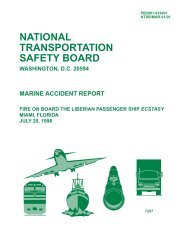Soot Deposits and Fires in Exhaust Gas Boiler - Martin's Marine ...
Soot Deposits and Fires in Exhaust Gas Boiler - Martin's Marine ...
Soot Deposits and Fires in Exhaust Gas Boiler - Martin's Marine ...
- No tags were found...
You also want an ePaper? Increase the reach of your titles
YUMPU automatically turns print PDFs into web optimized ePapers that Google loves.
)The p<strong>in</strong>ch po<strong>in</strong>t temperature of theboiler should be higher than about15°C or, even better, 20°C.c)The boiler’s exhaust gas outlet temperatureshould not be lower thanabout 165°C as otherwise condensationof sulphuric acid <strong>in</strong> the exhaustgas could make the soot sticky.d)The <strong>in</strong>let pip<strong>in</strong>g to the boiler shouldbe designed so that the gas flow velocitydistribution is as uniform as possible,<strong>in</strong> order to avoid local po<strong>in</strong>tswith a particularly low gas velocity.e)The exhaust gas design pressureloss across the boiler should be ashigh as possible - <strong>in</strong>creas<strong>in</strong>g the gasvelocity <strong>in</strong> the boiler. This means thatthe pressure losses <strong>in</strong> the rema<strong>in</strong><strong>in</strong>gparts of the exhaust gas systemshould be dimensioned as low aspossible (large pipe diameters).f) A dump<strong>in</strong>g condenser should be <strong>in</strong>stalledto control steam production/consumption.A gas by-pass valve <strong>in</strong>stalled to controlthe steam production would reducethe gas velocity <strong>in</strong> the boiler - <strong>and</strong>consequently <strong>in</strong>crease the risk of sootdeposits - <strong>and</strong> cannot, therefore, berecommended.The supplementary recommendationsbelow apply only to boilers of the watertube type:g)A by-pass duct with an automaticallyoperated on/off valve (open/closed at50% SMCR) may <strong>in</strong> certa<strong>in</strong> operat<strong>in</strong>gconditions be recommended for watertube boilers. If, for example, theship is often slow steam<strong>in</strong>g, i.e. thediesel eng<strong>in</strong>e operates at low load,such an <strong>in</strong>stallation will prevent sootdeposits on the boiler tubes by bypass<strong>in</strong>gall the gas <strong>and</strong> thereby avoid<strong>in</strong>glow gas velocities <strong>and</strong> the associatedrisk of soot deposits <strong>in</strong> the boiler.h)Automatic soot blowers for frequentclean<strong>in</strong>g should be <strong>in</strong>stalled <strong>in</strong> watertube boilers <strong>in</strong> order to clean the tubesof soot. The pressure of the soot blow<strong>in</strong>gmedium should be as high as possibledur<strong>in</strong>g the entire soot blow<strong>in</strong>g sequence.As the possible steam pressure usedis only about 7 barg, <strong>and</strong> <strong>in</strong> some cases6 barg, the use of high-pressure air willbe better.i) Fixed water wash<strong>in</strong>g system <strong>and</strong>/ormanual clean<strong>in</strong>g at regular <strong>in</strong>tervals.Water wash<strong>in</strong>g is performed <strong>in</strong> orderto clean the boiler completely of sootwhich has not been cleaned away bythe soot blowers. The exhaust gaspip<strong>in</strong>g between eng<strong>in</strong>e <strong>and</strong> boiler shouldbe so arranged that the boiler can becleaned more thoroughly from time totime when the eng<strong>in</strong>e is stopped <strong>in</strong>harbour without the risk of flood<strong>in</strong>g theeng<strong>in</strong>e/turbochargers with clean<strong>in</strong>g fluid.Water wash<strong>in</strong>g should preferably beundertaken while the tubes are stillhot, mak<strong>in</strong>g it easier to remove thesoot as it will “crack”.If the above-mentioned on/off exhaustbypass is <strong>in</strong>stalled, the boiler can bebypassed. Water wash<strong>in</strong>g shouldthen also be carried out dur<strong>in</strong>g seaservice as often as possible (when theexhaust pressure loss <strong>in</strong>creases), <strong>and</strong>not only dur<strong>in</strong>g stops <strong>in</strong> harbour. Afterwater wash<strong>in</strong>g, it should be checkedthat no soot is left, as rema<strong>in</strong><strong>in</strong>g wetsoot may <strong>in</strong>crease the risk of soot depositswhen cont<strong>in</strong>u<strong>in</strong>g operation.j) The water circulation temperature atthe boiler <strong>in</strong>let, for boilers with apreheater section, should be higherthan about 140°C as otherwise toolow temperatures could cause someof the gas constituents, such as fuel<strong>and</strong> lube oil vapour, to condense onthe cold boiler tube surfaces, <strong>and</strong> thiscould <strong>in</strong>crease the tendency towardssoot deposits.Another advantage of this is that thetemperature of the preheater tubesurfaces can then be higher than thedew po<strong>in</strong>t of the sulphuric acid <strong>in</strong> thegas, thus m<strong>in</strong>imis<strong>in</strong>g the risk ofsulphuric acid corrosion.Referr<strong>in</strong>g to ignition:k)The circulation water flow velocity<strong>and</strong> ratio at the boiler <strong>in</strong>let should beas high as possible <strong>in</strong> order to keepthe gas temperature at the boilertube surface as low as possible (<strong>in</strong>contrast to po<strong>in</strong>t j). The water flow ratio(water flow/steam production ratio)is recommended to be equal to orhigher than 6. This should reduce therisk of ignition of possible soot deposits,which can happen at temperaturesabove some 150°C <strong>and</strong>, underextreme conditions, even as low as120°C.It is therefore also very important toensure the best suction conditions sothat cavitation does not occur <strong>in</strong> thecirculat<strong>in</strong>g pumps under any work<strong>in</strong>gconditions, as otherwise the circulat<strong>in</strong>gwater flow could be reduced oreven stopped.A temperature monitor<strong>in</strong>g systemmounted above the boiler might be recommendableas a means of detect<strong>in</strong>g afire <strong>in</strong> the boiler as soon as it starts.Recommended operat<strong>in</strong>gconditionsIn view of the damage that can becaused by an extensive soot fire <strong>in</strong> theexhaust gas boiler, it is recommended,dur<strong>in</strong>g the operation of the ship, to givedue consideration to the follow<strong>in</strong>g:Normal operat<strong>in</strong>g conditionsa)<strong>Soot</strong>-blow<strong>in</strong>gIf soot-blow<strong>in</strong>g equipment is <strong>in</strong>stalled,we recommend check<strong>in</strong>g its efficiency<strong>and</strong> adjust<strong>in</strong>g the number ofdaily soot-blow<strong>in</strong>gs accord<strong>in</strong>gly.This document, <strong>and</strong> more, is available for download at Mart<strong>in</strong>'s Mar<strong>in</strong>e Eng<strong>in</strong>eer<strong>in</strong>g Page - www.dieselduck.net19
















